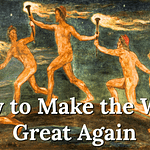“This is the way the world ends. Not with a bang but a whimper.”
T.S. Eliot, The Hollow Men
Throughout Western history, the idea of civilizational collapse has been bound up with visions of apocalyptic catastrophe caused by invasions, plagues, war, or natural disasters. But today, the greater danger may be a dark age of sterility and stagnation that lasts for centuries. In this dystopian scenario, nothing collapses outright, yet nothing vital is created. Civilization settles into a state of weariness and futility that is sustained by just enough material comfort to stifle the impetus for revolution or renaissance. In his book The Decadent Society, Ross Douthat calls this civilizational condition decadence, and he defines it as “economic stagnation, institutional decay, and cultural and intellectual exhaustion at a high level of material prosperity…It describes a situation in which repetition is more the norm than innovation; in which sclerosis afflicts public institutions and private enterprises alike; in which intellectual life seems to go in circles…” (Ross Douthat, The Decadent Society)
In this video, we explore whether our civilization has entered a dark age of decadence.
In his magnum opus, From Dawn to Decadence: 500 Years of Western Cultural Life, the great 20th century historian Jacques Barzun wrote:
“This sense of a [civilizational] ending need not mean stoppage or total ruin… All that is meant by Decadence is falling off… It implies in those who live in such a time no loss of energy or talent or moral sense. On the contrary, it is a very active time, full of deep concerns, but peculiarly restless, for it sees no clear lines of advance. The forms of art as of life seem exhausted; institutions function painfully. Repetition and frustration are the intolerable result. Boredom and fatigue are great historical forces…When people accept futility and the absurd as normal, the culture is decadent.”
Jacques Barzun, Dawn to Decadence: 500 Years of Western Cultural Life
While apocalyptic visions of collapse capture the imagination, history suggests that civilizations more often decline through decadence than sudden catastrophe. Ancient Rome is a classic example. After the Crisis of the Third Century – when foreign invasions, economic turmoil, and the assassination of Emperor Severus Alexander nearly tore the empire apart – Rome endured for centuries in a state of decadence. The poet W.H. Auden remarked:
“…the Roman Empire is like a mirror in which we see reflected the brutal, vulgar, powerful yet despairing image of our technological civilization…What fascinates and terrifies us about the Roman Empire is not that it finally went smash, but that it managed to last for four centuries without creativity, warmth, or hope.”
W.H. Auden, Review of Rome and Villa
Likewise, G.K. Chesterton observed:
“There was nothing left that could conquer Rome, but there was also nothing left that could improve it… It was the end of the world, and the worst of it was that it need never end.”
G.K. Chesterton, The Everlasting Man
At first glance, it may seem wrong to call our civilization decadent. After all, one of the characteristics of decadence is economic stagnation and a decline in innovation. Don’t we live in an era where rapid technological innovation is fueling economic growth and improving the quality of life? Douthat challenges this idea, for as he writes:
“The question is whether our sense of continued [technological] acceleration is now to some extent an illusion created by the Internet—the one area of clear technological progress in our era, but also a distorting filter on the world beyond your screen.”
Ross Douthat, The Decadent Society
In the late 19th century, within a span of approximately 50 years, civilization was transformed by the invention of the electric lightbulb, indoor plumbing, automobiles, airplanes, the internal combustion engine, the camera, telephone, air conditioning, and refrigeration. The historian Perry Miller called this the era of the “technological sublime,” when inventions inspired an awe equal to that elicited by cathedrals or mountains. And as Ross Douthat observed: “From the early nineteenth century onward, the recurrence of such moments [of the technological sublime] in America and the West became almost liturgical, with each new technological breakthrough offering a kind of pilgrimage or festival.” (Ross Douthat, The Decadent Society)
Since 1970, the most transformative innovations – the computer, the internet, and the smartphone – have revolutionized the way we work, communicate, and access information. Yet their influence has been concentrated in the digital sphere. Outside the digital realm, innovations that have radically changed our day-to-day existence are few and far between as most progress has consisted of improvements to already existing technologies.
What is more, according to a 2022 study titled “Entrepreneurship and the Decline of American Growth” by the Joint Economic Committee, entrepreneurship in the U.S. has declined significantly since the late 1970s. New business formation has fallen by 44%, and startups as a share of all firms have dropped from around 16.5% to just 8%. We are, as a society, less creative and innovative than we used to be. And as Douthat writes:
“…the basic stagnationist case: We used to travel faster, build bigger, live longer; now we communicate faster, chatter more, snap more selfies…Everyday life was, indeed, more radically transformed by earlier technological breakthroughs. And over the last two generations, the only truly radical change has taken place in the devices that we use for communication and entertainment, so that a single one of the nineteenth century’s great inventions still looms larger in our everyday existence than most of what we think of as technological breakthroughs nowadays.”
Ross Douthat, The Decadent Society
Just as revolutionary innovations have slowed to a halt in the last 50 years, so has economic progress. While wages, household income, and net worth have all risen over the past decades, much of these gains have been offset by taxes and money printing. In many countries when all taxes are combined, such as sales taxes, income taxes, capital gains taxes, property taxes, and tariffs and other duties, many of us pay more than 50% of our income to fund the rampant waste and corruption of statist governments. To make matters worse we are further looted through money printing, which acts as an invisible tax as the purchasing power of our savings decreases when central banks increase the money supply. The rampant expansion of the money supply, in other words, is papering over the stagnation that defines most economies across the globe. And as Douthat comments:
“The United States is still an extraordinarily wealthy country … but it’s entirely reasonable to look at the last fifty years of developed-world economic history … and see an era of deceleration followed by stagnation.”
Ross Douthat, The Decadent Society
But decadence is evident not only in the economy and the decline of innovation, as biological sterility is mirroring the sterility of civilization at large. Fertility rates across the West – once safely above replacement levels – have been declining for decades but since the 2008 financial crisis have plunged to levels that, if sustained, will result in the asymptotic decline of entire races of peoples. Even the United States, long an exception with comparatively robust birth rates, has now joined European countries and Japan in the ranks of countries with sub-replacement fertility rates. Increasingly, individuals are either choosing to forego parenthood or find themselves unable to conceive, hindered by plummeting testosterone and sperm levels, or female infertility.
“There is variation from country to country, culture to culture, but below-replacement fertility is the fundamental fact of civilized life in the early twenty-first century.”
Ross Douthat, The Decadent Society
Low birth rates are resulting in rapidly aging populations that are burdening the welfare system and, due to the risk averse nature of the elderly, slowing innovation and economic growth. But at a more fundamental level, declining fertility rates are signaling a widespread loss of hope in the future. Many people are choosing not to have children because they have accepted futility as the norm, which Jacques Barzun described as one of the fundamental features of a decadent culture. And as Douthat continues:
“In a world where every culture and society can seem to be converging [into decadence], Africa is the outlier: [it is] youthful in a graying world, and fertile in an age of sterility and demographic decline…In the late 1990s, Europe and Africa had about the same population; a hundred years later, there could be seven Africans for every European. Even with the Mediterranean between them, and the Sahara as an impediment, that kind of equilibrium cannot be plausibly sustained. In some form or another, manageable or not, Eurafrica is coming…Overall, by 2100, two out of every five human beings could be African.”
Ross Douthat, The Decadent Society
Decadence can also be seen in entertainment and the arts. For as Jacques Barzun noted, a decadent culture is one of “repetition and frustration” that produces “boredom and fatigue.” In other words, it is a culture that no longer creates the new but endlessly recycles and repeats the old. Douthat notes of a study which found that the diversity of and transition between chords has declined in pop music since the 1960s, and lyrics of Top 40 songs have become increasingly repetitive. What is more, of the top 30 most played Christmas songs today, 22 were written between 1940 and 1970.
But the repetition that characterizes artistic decadence is perhaps most glaring in the film industry. Of the 25 top-grossing films in 2019, only three featured original stories and characters. The remaining 22 were sequels, remakes, or parts of existing franchises. By contrast, between 1950 and 1979, 90% of the top 25 films introduced new stories and characters to audiences. Or as Douthat notes, the movie industry today has confined itself to “the constant recycling of famous properties that originated as mass-market entertainments between the 1930s and the 1970s.” Or as he continues:
“We have reached a point where comic-book and sci-fi franchises are not a big part of the movie business…They are not the biggest part of the movie business. They are the movie business. Period.”
Ross Douthat, The Decadent Society
With economic and cultural stagnation becoming the norm many are retreating into the digital cocoon of the Internet and chasing entertainments that offer cheap pleasures and superficial distractions. Others are seeking escape in substances such as alcohol, marijuana, and hard drugs, as seen first in the opioid epidemic and now in the fentanyl crisis. While in the 1960s and 70s, the drugs of choice were hallucinogens, which at least have the potential to expand the mind and spark creativity, today, as Andrew Sullivan noted in New York Magazine:
“The drugs conquering America are downers: they are not the means to engage in life more vividly but to seek a respite from its ordeals… Once the high hits, your head begins to nod and your eyelids close.”
Andrew Sullivan, The Poisons We Pick
Downers are the drugs of choice in a decadent culture as they help numb people to the futility and frustration that pervades modern life. Or as Douthat wrote:
“None of the commercial marijuana products or illegal fentanyls can yet match the qualities of Aldous Huxley’s “soma” in Brave New World—the “perfect drug,”… But [the drugs] have some clear Huxleyan effects, insofar as they offer a temporary exit from ordinary discontents for precisely the kind of people who might otherwise be inclined to rebel or smash things up, to join a cult or start a revolution, or to opt out like the early Christians in some radical, society-altering way. They wreck lives, but they may also stabilize society; they cull unhappy people, via overdose or just a numb unhealthiness…And the drugs pair with the virtual entertainments in the same way that soma pairs naturally with other features of the Brave New World World State. Huxley’s perfectly stabilized society had the “feelies”—essentially VR sex. We are not so far away from something similar, at the place where sex robots and Oculus Rift converge.”
Ross Douthat, The Decadent Society
Just like in Brave New World, the comfortably numb masses of the modern day are proving easy prey for authoritarianism – which is taking the form of what the author James Poulos called the “pink police state.” Unlike the brutal regimes of the 20th century, which were fueled by revolutionary upheaval, the pink police state is growing from the soil of cultural decadence. Overcome by a sense of fatigue and futility, people today no longer want the responsibilities and risks of freedom – they want to be kept safe and taken care of by the government. And so political power is reshaping itself accordingly. It now bears, as Ross Douthat observes, “an authoritarian edge—a gently despotic aspect—under a banner that isn’t the red of Communism or the black and brown of fascism, but a friendly, helpful, cheerful color. The color of a nurse, of a caregiver, of the kindliest possible inquisitors: the gentle, childlike color pink.” (Ross Douthat, The Decadent Society)
The pink police state is the modern form of what Alexis de Tocqueville described as soft despotism. In such a system, citizens are free to indulge in pleasure, consume, and be entertained – but only within boundaries drawn by a managerial elite. The surveillance state watches, the bureaucratic state regulates, and the cultural state enforces orthodoxy, all under the banners of safety, sensitivity, diversity, and inclusion. The liberties to consume – even if it be hard drugs on public streets – and express oneself – even if it means flaunting one’s sexuality in public – are held to be sacred. While the truly sacred freedoms – such as freedom of speech, religion, association, and dissent, as well private property rights – are gradually eroded in the name of the greater good. Or as Ross Douthat observes:
…the pink police state partially erases the idea of a public/private divide, replacing it with alternative binaries of health/disease and safety/danger instead. Social problems in this landscape are increasingly medicalized, with the language of treatment rather than moral exhortation a default response to any kind of disruption or unhappiness. Private conduct is freer in the variety of acts that are allowed, but more closely regulated in any case where there is a possibility of not just physical but also psychological harm. And certain older political and religious liberties fall more on the “harm” or “danger” side of the new binaries, because religious exclusion or moral discrimination might wound the individual’s sense of well-being, and political speech might likewise express an antipathy that becomes hateful, therefore damaging, therefore unacceptable.”
Ross Douthat, The Decadent Society
Part of what makes civilizational decadence so insidious is that, like all dystopias, most people living within it do not recognize it as dystopian. As human beings we are highly adaptable and we can learn to accept absurdity and futility as normal, sterility as stability, repetition as routine, and authoritarianism as freedom. But just because we grow accustomed to decadence does not mean it is harmless. A civilization that succumbs to decadence is at risk of stagnating for centuries in a dark age or else collapsing outright in disaster.
“…one of the recurring critiques of the decadent society is that its stability is an illusion, that sustainable decadence is a contradiction in terms, and that decadence always makes a civilization uniquely vulnerable to crisis, invasion, destruction.”
Ross Douthat, The Decadent Society
Yet as he continues:
“The only thing more frightening than the possibility of annihilation is the possibility that our society could coast on forever as it is—like a Rome without an Attila to sack its palaces, or a Nineveh without Yahweh to pass judgment on its crimes.”
Ross Douthat, The Decadent Society
For those who care about the fate of civilization, the great task before us is to acknowledge that our civilization is decadent, and to recognize that even within a decadent age it is still possible to live well. We can be fruitful amid sterility, creative amid repetition, and we can carve out spaces of vitality that stand in defiance of the surrounding cultural exhaustion. These acts of individual renewal are necessary, for they preserve the spark of human dignity and keep alive the possibility of a wider cultural rebirth. Yet this is not a task that can be left to a few; if too many of us allow the wider cultural futility to infect our minds, decadence will harden into destiny and our civilization may succumb to a centuries long dark age of sterility and exhaustion. Or as Ross Douthat warns:
“If attempts to lurch upward from decadence can risk disaster, the unresisted drift of decadence leads, however slowly and comfortably, into a territory of darkness, a posthuman landscape as barbarous as it is posh, whose sleekness covers over a sickness unto death…it always remains possible to imagine and work toward renewal and renaissance…a cultural revolution powerful enough to escape the gravitational pull of decadence may even now be taking shape.”
Ross Douthat, The Decadent Society










